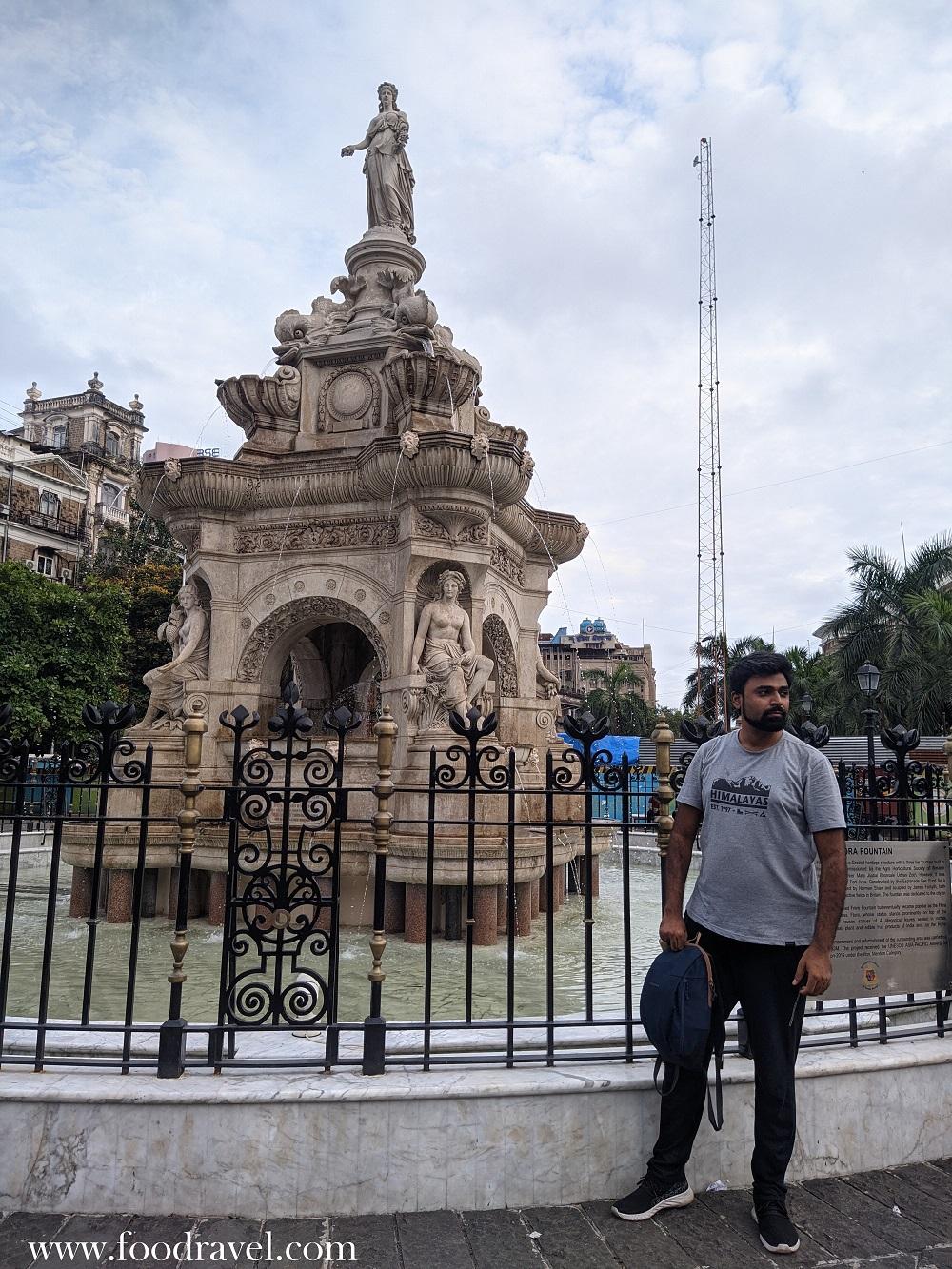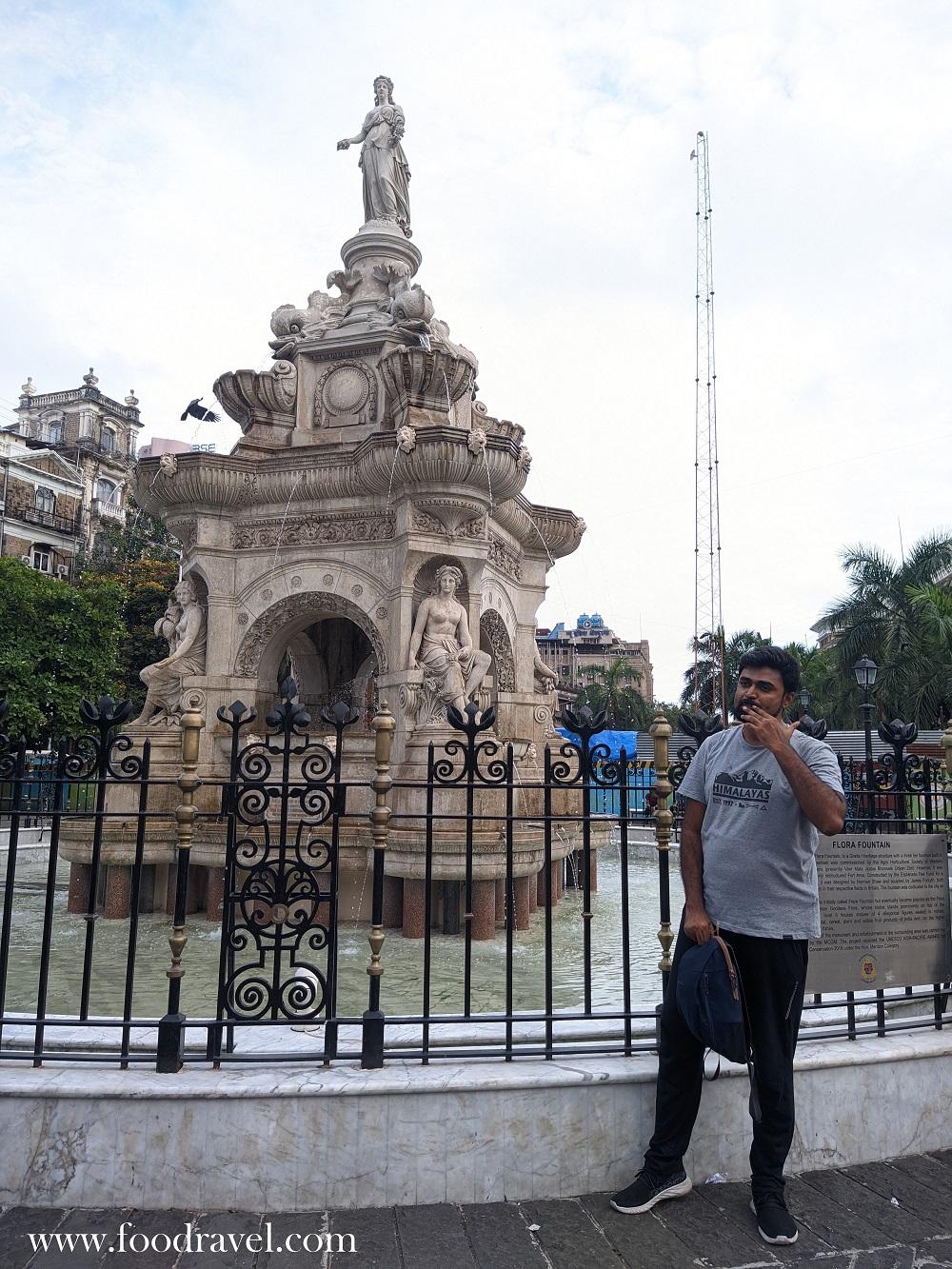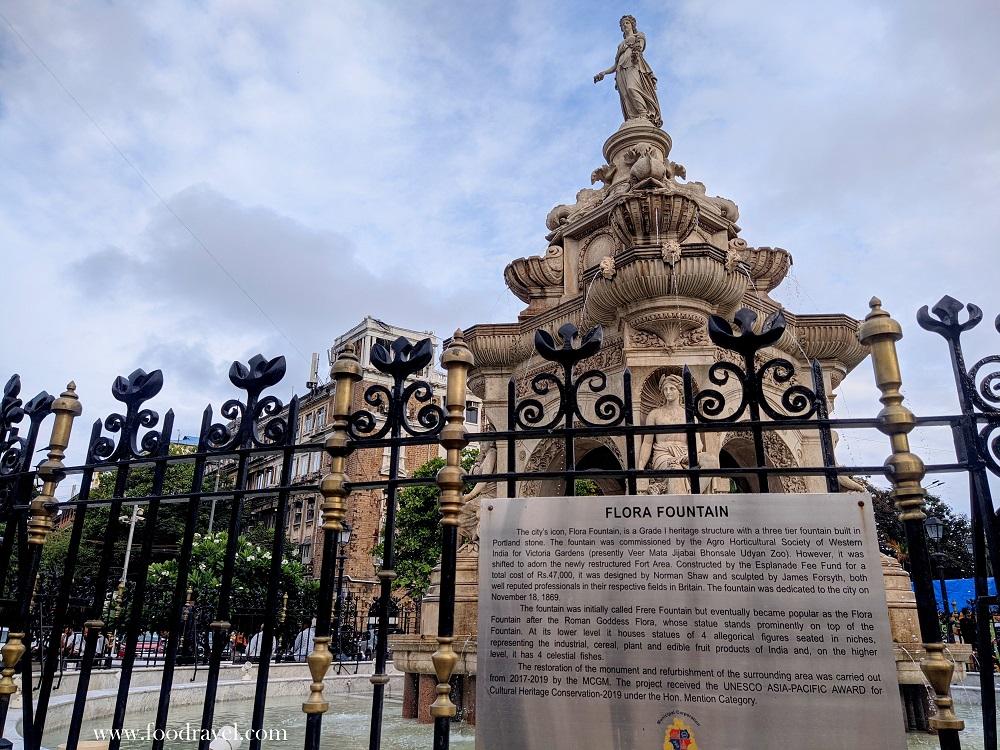Lost in the labyrinth of Mumbai’s bustling streets, I found myself meandering aimlessly, a wanderer in the sea of hurried footsteps and honking horns. The city’s chaotic rhythm enveloped me, leading me from one corner to another, without a specific destination in mind. Amidst the cacophony of the metropolis, a momentary hush engulfed me as I stumbled upon a sight that would captivate my heart, the magnificent Flora Fountain.
Rising gracefully amidst the urban sprawl, Flora Fountain stood like a majestic sentinel, a testament to Mumbai’s rich history and architectural grandeur. Its intricate design and sculpted beauty seemed to beckon me closer, as if inviting me to unveil the secrets hidden within its ornate structure. Drawn by an inexplicable force, I felt an irresistible urge to delve deeper into the story that this iconic monument held within its walls.
With each step I took towards its grand presence, the clamor of the city faded into the background, making way for the whispers of history and heritage that echoed around me. It was as if time stood still, offering a serene escape from the relentless pace of Mumbai. In the heart of the city’s ceaseless motion, I had discovered an oasis; a place where past and present converged, where the legacy of bygone eras melded seamlessly with the vibrant spirit of modernity.
As I stood in awe before Flora Fountain, I couldn’t help but marvel at the timeless allure of this architectural marvel. Its creation dated back to the late 19th century when Mumbai was Bombay, and British colonial influences shaped the city’s landscape. Over the years, Flora Fountain had witnessed the transformation of the metropolis, preserving the memories of generations while gracefully embracing the contemporary spirit of Mumbai.
Join me on this serendipitous journey as I recount the awe-inspiring encounter with Flora Fountain. Together, we will embark on a voyage of discovery, exploring the rich history, architectural grandeur, and cultural significance of this beloved landmark. Let us lose ourselves in the tales woven into its stone, and be forever enchanted by the spellbinding essence of Flora Fountain, a gem hidden amidst the vibrant tapestry of Mumbai, waiting to be explored and cherished by all who wander its way.

As I stood in the presence of Flora Fountain, I couldn’t help but be intrigued by the stories that must lie within its very foundations. To truly appreciate its grandeur, I embarked on a historical journey that would transport me back to the time of its inception.
Flora Fountain was built in the 1860s, a period when Mumbai was rapidly evolving under British colonial rule. The fountain’s creation was a tribute to Sir Bartle Frere, a distinguished British administrator, who served as the Governor of Bombay from 1862 to 1867. Designed by R. Norman Shaw, a renowned British architect, Flora Fountain was brought to life by skilled artisans and craftsmen who toiled tirelessly to transform Shaw’s vision into reality.
Originally named after Flora, the Roman goddess of flowers, the fountain epitomized the amalgamation of British architecture with Indian craftsmanship. Its intricate carvings and exquisite sculptures showcased a fusion of European Gothic and Indo-Saracenic styles, a testament to the cultural harmony that permeated Bombay during that era.
Over the years, Flora Fountain witnessed significant events that shaped the course of Mumbai’s history. It stood as a silent spectator during India’s struggle for independence, witnessing the tides of change and the sacrifices made by the freedom fighters. The renaming of the monument to Hutatma Chowk, meaning “Martyr’s Square,” in honor of the Samyukta Maharashtra movement in the late 1950s, added another layer of significance, commemorating the bravery and determination of those who fought for a unified Maharashtra state.
Despite the passage of time and the city’s ever-changing landscape, Flora Fountain has retained its timeless allure, symbolizing the resilience and spirit of Mumbai. Its presence serves as a reminder of the city’s heritage, an architectural gem that stands tall amidst the bustling metropolis, connecting the past with the present.
As I immersed myself in the historical depths of Flora Fountain, I couldn’t help but marvel at its enduring legacy—a testimony to the remarkable journey of Mumbai, and a treasure trove of stories waiting to be unraveled. With newfound appreciation and curiosity, I prepared to delve even deeper into the artistic marvels that adorned its sculpted walls, eager to discover the tales that awaited me at every turn.

Architectural Marvels and Artistic Delights
As I moved closer to Flora Fountain, the intricate details of its architecture began to unfold before my eyes. It was a mesmerizing sight—a symphony of artistry etched in stone. The fountain’s design was nothing short of a masterpiece, reflecting the vision and skill of its architects and craftsmen.
The central statue of Flora, after whom the fountain was originally named, stood gracefully atop the fountain, her graceful figure draped in flowing robes. Carved with meticulous precision, Flora exuded an aura of elegance and grace, symbolizing abundance and the bountiful nature of the region. Each delicate fold of her gown seemed to come alive, as if caught in a gentle breeze. Around her, four intricately crafted maidens adorned the lower tier, representing the four seasons—Spring, Summer, Autumn, and Winter—each exuding their unique charm.
Beyond the statues, the fountain’s pillar showcased an array of bas-reliefs that depicted scenes from Indian mythology and folklore. These exquisitely carved panels narrated tales of gods, goddesses, and mythical creatures, invoking a sense of wonder and reverence. Each panel was a work of art, bearing witness to the craftsmanship and creativity of the skilled artisans who had poured their hearts into every chisel mark.
Flora Fountain’s canopy, supported by beautifully crafted pillars, provided a sense of shelter and grandeur. The intricate details on these pillars boasted an array of motifs—floral patterns, mythical creatures, and geometrical designs—all blending harmoniously to create an awe-inspiring spectacle.
As I walked around the fountain, exploring every nook and cranny, I marveled at the fusion of architectural styles that adorned Flora Fountain. The imposing Gothic arches, a hallmark of British architecture, coexisted gracefully with the Indo-Saracenic elements, reflecting India’s cultural identity. It was a symphony of aesthetics—a seamless blend of the East and the West.
At that moment, I realized that the Flora Fountain was not merely a structure made of stone and mortar; it was a living testament to the artistry and creativity of a bygone era. Each sculpture and carving told a story—a story of Mumbai’s history, of the people who shaped the city, and of the cultural tapestry that adorned its streets.
As the sun began to set, casting a warm golden glow on Flora Fountain’s intricate carvings, I couldn’t help but be grateful for this enchanting encounter. Flora Fountain had captured not only my attention but also my heart, leaving an indelible impression that would forever be etched in my memory.

Symbolism and Significance - Flora Fountain's Deeper Meaning
Beyond its stunning beauty and architectural splendor, Flora Fountain holds a deeper meaning and cultural significance that resonates with the spirit of Mumbai. As I delved deeper into its history, I discovered the rich symbolism imbued within every facet of this iconic monument.
Flora, the graceful Roman goddess of flowers and the fountain’s central statue, represents the abundance of nature, linking the monument to Mumbai’s flourishing landscape. The seasonal maidens encircling her symbolize the cyclical nature of life, reflecting the city’s ever-changing rhythms. Flora’s presence at the heart of Mumbai serves as a gentle reminder of the city’s resilience and prosperity, even in the face of challenges.
The bas-reliefs on the fountain’s pillar offer a glimpse into India’s diverse cultural heritage. Each panel, meticulously sculpted, depicts mythological tales and legends that have shaped the country’s ethos. As one of Mumbai’s most prominent landmarks, Flora Fountain bridges the gap between past and present, celebrating the country’s cultural legacy while embracing its cosmopolitan present.

The fusion of architectural styles also speaks to the city’s identity as a melting pot of cultures. Flora Fountain’s amalgamation of Gothic and Indo-Saracenic elements represents the harmonious coexistence of different cultural influences in Mumbai. It stands as a symbol of unity, echoing the spirit of tolerance and acceptance that defines this vibrant metropolis.
Moreover, the renaming of the monument to Hutatma Chowk adds layers of historical and emotional significance. The martyr’s square commemorates the sacrifice of brave souls who laid down their lives during the Samyukta Maharashtra movement, a pivotal moment in Maharashtra’s quest for linguistic reorganization. The new name serves as a poignant reminder of the struggle for regional identity and unity.
Flora Fountain has transcended its physical presence, becoming woven into the fabric of Mumbai’s collective memory. It has served as a silent witness to historical events, a gathering point for celebrations, and a source of inspiration for artists and writers. The fountain’s enduring legacy is a testament to the deep connection it shares with the people of Mumbai.
As I stood amidst the grandeur of Flora Fountain, I couldn’t help but feel a profound sense of reverence for this captivating landmark. Beyond its artistic appeal, it held within it the soul of Mumbai—a city that embraces its heritage while embracing the future. Flora Fountain’s symbolism and significance were a reflection of Mumbai’s spirit—a city that cherishes its history, celebrates its diversity, and continues to thrive with an unwavering zest for life.

A Few Moments of Serenity at Flora Fountain
In the heart of the bustling city, Flora Fountain offers a haven of serenity—a respite from the cacophony of urban life. As I spent time in its presence, I couldn’t help but marvel at the tranquility that enveloped the surroundings. It was as though time had slowed down, allowing me to savor the moments of peace and reflection.
With each passing moment, I found myself drawn to the soothing sound of water flowing from the fountain. The gentle splashes and ripples created a calming melody, lulling me into a state of contemplation. Around me, people from all walks of life gathered, seeking solace and a moment of reprieve from their hectic routines.
Flora Fountain’s ethereal charm extended beyond its physical beauty—it exuded an intangible aura that touched the hearts of those who visited. Couples found a romantic spot to steal glances and create cherished memories, while families basked in the fountain’s cooling mist, forging bonds amidst the shared joy.
The surrounding architecture provided a picturesque backdrop for artists and photographers, who captured the essence of Flora Fountain through their lenses and canvases. Writers and poets found inspiration in its timeless allure, penning verses that echoed the poetry of Mumbai’s soul.

As I sat by the fountain, I couldn’t help but lose myself in a myriad of emotions. Flora Fountain had a way of evoking a sense of nostalgia, as if echoing the memories of generations that had sought refuge in its shadows. The laughter of children, the chatter of passersby, and the symphony of city life melded seamlessly with the fountain’s mystique, creating a symphony of life and art.
In those few moments, Flora Fountain became more than just a historical landmark—it became a part of my own story. Its grandeur and grace left an indelible impression on my heart, reminding me of the beauty that could be found in unexpected encounters. I felt a profound connection to this architectural marvel, as if the fountain itself had become a confidant—a silent listener to the tales of the city and its people.
As the day drew to a close, and the city lights illuminated the Flora Fountain, I bid a fond farewell to this enchanting sanctuary. Flora Fountain had been more than just a place to visit—it had been an experience that enriched my soul and deepened my appreciation for the treasures hidden amidst the bustling chaos of Mumbai.

Embracing Culture - Flora Fountain as a Cultural Hub
Flora Fountain transcends its role as a mere architectural wonder and takes on a new dimension—a vibrant cultural hub that embraces the essence of Mumbai’s artistic spirit. Throughout the year, the fountain square becomes a canvas for diverse cultural celebrations and artistic expressions, infusing the city with an aura of festivity and creativity.
One of the most captivating aspects of Flora Fountain is its ability to host a myriad of cultural events and festivals. From traditional dance performances to musical concerts, the square comes alive with the rhythm of Mumbai’s cultural heritage. Local artists and performers showcase their talents, captivating audiences with their passion and creativity.
The annual Kala Ghoda Arts Festival, a celebration of art, culture, and heritage, finds its heart at Flora Fountain. The square transforms into an open-air gallery, adorned with vibrant art installations and captivating sculptures. It becomes a meeting ground for artists, artisans, and enthusiasts from around the world, fostering a sense of camaraderie and appreciation for the arts.

Literary events and book fairs also find a home at Flora Fountain, attracting bibliophiles and writers alike. The fountain’s serene ambiance provides the perfect setting for book readings, poetry sessions, and intellectual discussions. In this cultural haven, the love for literature blossoms, bridging the gap between words and hearts.
Flora Fountain’s cultural significance extends beyond the realm of arts and performances. It serves as a backdrop for social gatherings and moments of solidarity. Protests, rallies, and public gatherings often find their place here, making it a symbol of civic engagement and democratic expression.
As I witnessed the various cultural activities unfold at Flora Fountain, I couldn’t help but be in awe of the city’s vibrancy and inclusivity. It was a testament to Mumbai’s ethos—a city that embraces diversity and encourages creativity to flourish. Flora Fountain played an instrumental role in nurturing this cultural dynamism, welcoming all to partake in the tapestry of Mumbai’s artistic soul.
As the sun set on another day of cultural revelry at Flora Fountain, I left with a sense of admiration for this dynamic landmark. It had transformed from a solitary monument to a stage for cultural celebration—a place where traditions and contemporary expressions intertwined seamlessly, creating a harmonious symphony of life.
As my journey at Flora Fountain comes to a close, I am filled with a deep sense of gratitude for this enchanting encounter. Flora Fountain, with its architectural marvels, artistic delights, and cultural significance, has left an indelible mark on my heart.
This iconic monument stands as a timeless tapestry—a convergence of history, art, and culture—that weaves its way into the very fabric of Mumbai’s identity. Its graceful presence serves as a reminder of the city’s rich heritage, reflecting the resilience and prosperity that define Mumbai.
Flora Fountain has welcomed generations, inviting them to find solace in its serene ambiance and artistic splendor. It is a sanctuary that fosters creativity, nurturing the city’s vibrant artistic spirit. Its significance as a cultural hub embraces the diverse expressions of Mumbai’s cultural landscape, uniting people from all walks of life in celebration of creativity and camaraderie.
As I bid farewell to this majestic landmark, I carry with me a treasure trove of memories—a collection of moments that have enriched my soul and deepened my appreciation for the beauty that lies within the bustling cityscape. Flora Fountain is more than just a fountain—it is a living entity, a witness to the ever-changing rhythm of Mumbai, a canvas for artistic expression, and a symbol of the city’s enduring spirit.
In the heart of Mumbai’s urban maze, Flora Fountain stands tall—a testament to the city’s past, an emblem of its present, and a beacon for its future. It embodies the essence of Mumbai—a city that embraces its history while embracing the dreams of tomorrow.
As I walk away from Flora Fountain, I carry its enchantment with me—a reminder that amid the chaos of life, there are hidden gems waiting to be discovered, and moments of serenity to be found in the most unexpected corners.
Flora Fountain, with its grace and grandeur, will forever hold a special place in my heart, and I look forward to returning to its embrace whenever the city calls me back for another delightful rendezvous.
![]()


